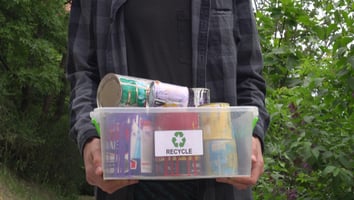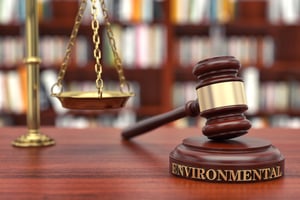One often overlooked provision of the Resource Conservation and Recovery Act (RCRA) is the...
Introduction to RCRA: Definition of a Hazardous Waste
Introduction
The Resource Conservation and Recovery Act (RCRA) is a critical piece of American environmental legislation that governs the handling and management of solid an hazardous waste from point of generation to final disposal. Understanding how RCRA defines a hazardous waste is the first step to compliance with the various rules and regulations designed to help businesses protect human health and the environment. This post will provide a brief overview of RCRA and delve into the how the hazardous waste is identified within the statute.
A Brief History of the Resource Conservation and Recovery Act
RCRA was enacted in 1976 to address a series of waste management crises in the United States. The act has since been amended several times throughout the years, most notably the Hazardous and Solid Waste Amendments (HSWA) in 1984. These amendments bolstered the law's provisions on hazardous waste and created many of the current rules governing the management of hazardous waste.
In general, RCRA has three main goals:
- Protect human health and the environmental from the potential hazards of waste handling and disposal.
- Conserve energy and natural resources through waste recycling and recovery.
- Reduce the amount of waste generated and ensure that waste is managed in an environmentally sound manner.
Definition of Hazardous Waste
RCRA defines hazardous waste as any solid waste that poses substantial or potential threats to public health or the environment. There are two main categories of hazardous waste: wastes that are listed by the EPA as hazardous and wastes ("listed wastes") and wastes that exhibit one of the four characteristics of hazardous waste ("characteristic wastes"). Each listed waste and hazardous characteristic is assigned a four digit alphanumeric waste code to help identify and characterize wastes determined to be hazardous.
Types of Hazardous Waste:
-
Listed Wastes:
- F-List: Spent wastes from common, non-specific manufacturing and industrial processes, such as solvents used in cleaning or degreasing. F-listed wastes receive hazardous waste codes F001 - F039. The full list of F-coded waste can be found at 40 CFR Section 261.31.
- K-List: Spent Wastes from certain specific industrial processes, such as petroleum refining or pesticide manufacturing. K-listed wastes receive hazardous waste codes K001 - K181. The full K list can be found at 40 CFR section 261.32.
- P-List: Discarded, unused commercial chemical products that are considered to be acutely hazardous. P-listed wastes receive hazardous waste codes P001 - P205.
- U-List: Discarded, unused commercial chemical products that are not considered an acute hazard. U-listed waste received codes U001 - U411.
The full P and U lists can be found at 40 CFR section 261.33.
-
Characteristic Wastes:
- Ignitability (D001): Wastes that can easily catch fire (such as flammable solvents), or accelerate fire (such as oxidizers). Ignitable wastes receive the hazardous waste code D001.
- Corrosivity (D002): Wastes that can corrode metals or aqueous wastes with a pH below 2 or above 12.5. Corrosive wastes receive the waste code D002.
- Reactivity (D003): Wastes that are unstable or can cause explosions or toxic fumes. The full definition of reactivity Reactive wastes receive the waste code D003.
- Toxicity (D004 - D043): Wastes that are harmful when ingested or absorbed. The toxicity of a waste is determined by testing for one the presence of one of the EPA's toxic contaminants. A list of these contaminates and their regulatory levels can be found at 40 CFR section 261.24. Toxic wastes are assigned waste codes D004 - D043, depending on the contaminates present.
Identification of Hazardous Waste
A. Steps to Identify Hazardous Waste
- Determine if the material is a solid waste: Not all solid wastes are hazardous, but all hazardous wastes are solid wastes. A list of solid waste exclusions can be found at 40 CFR 261.4(a)
- Evaluate hazardous waste exclusions: Certain solid wastes are excluded from hazardous waste regulations. A list of hazardous waste exclusions can be found at 40 CFR 261.4(b)
-
Identify characteristics or listings: Determine if the waste is listed or exhibits one of the hazardous characteristics.
B. Testing and Analysis Methods Used to Identify Hazardous Waste
- Laboratory Tests: Conducting tests such as the Toxicity Characteristic Leaching Procedure (TCLP) to determine toxicity, flash point to determine ignitability, etc.
- Safety Data Sheets (SDS): Reviewing chemical information provided by manufacturers. Note: A product SDS is not sufficient by itself to properly characterize a spent waste!
- Process Knowledge: Using knowledge of the materials and processes generating the waste to identify potential contaminates and determine if further analysis is needed.
Regulatory Requirements and Management
Generator Responsibilities
Generators of hazardous waste have several responsibilities, including:
- Making accurate hazardous waste determinations.
- Keeping detailed records and submitting required reports.
- Properly labeling and storing hazardous wastes to prevent spills or accidents.
We will dive deeper into these responsibilities and regulatory requirements in later posts.
Common Misconceptions and Challenges
A. Misconceptions about Hazardous Waste Identification
Many people mistakenly believe that all toxic substances are classified as hazardous waste or that only industrial facilities generate hazardous waste. Understanding the precise definitions and criteria is crucial for accurate identification and compliance.
B. Challenges in Hazardous Waste Management
- Small Quantity Generators: Smaller businesses may struggle with compliance due to limited resources.
- State Regulations: Variations in state regulations can create confusion; it’s essential to understand both federal and state requirements.
Conclusion
Understanding the definition of hazardous waste is the first step to proper management of these wastes under RCRA. Compliance with these rules is essential for businesses to help prevent potential hazards, promote sustainable waste management practices and avoid financial liability for non-compliance. If you are unsure about your responsibilities under RCRA you're not alone. Stay informed and seek professional guidance when needed.
For more information, check out the following resources:
- RCRA Training Modules on the EPA Website.
- RCRA Online Database for a searchable library of documents and publications related to the Resource Conservation and Recovery Act.
- RCRA in the eCFR for the raw text of the law.



